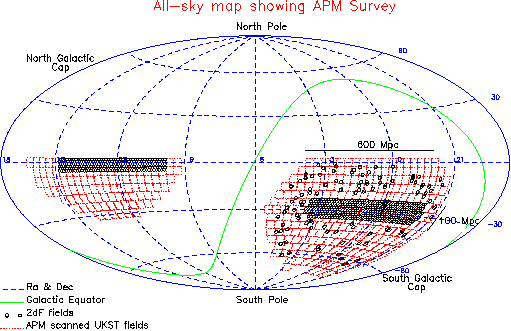The 2dF Galaxy Redshift Survey (2dFGRS) is a major new spectroscopic survey which aims to take full advantage of the unique capabilities of the 2dF facility built by the Anglo-Australian Observatory. The 2dFGRS is integrated with the 2dF QSO survey.
The 2dFGRS aims to obtain high-quality spectra and redshifts for 250,000 galaxies brighter than an extinction-corrected magnitude limit of bJ=19.45. The galaxies cover an area of approximately 2000 square degrees selected from both the southern galactic cap APM Galaxy Survey and the northern galactic cap equatorial region. The arrangement of survey fields is shown below.
The 2dFGRS survey and its database are described in detail in Colless et al. (2001). The figure below shows the map of the galaxy distribution produced by the survey as of June 2001 (a larger GIF and a Postscript image are also available, as is the map of the galaxies in the 100k release, as GIF and Postscript - see the 2dFGRS gallery for more images).
The survey will be used to address a variety of fundamental problems in galaxy formation and cosmology. In particular the survey will provide:
- Accurate measurements of the power spectrum of galaxy clustering on scales >30h-1 Mpc allowing, for the first time, a direct comparison with microwave background anisotropy measurements of fluctuations on the same spatial scales - see Percival et al. (2001).
- Measurements of the distortion of the clustering pattern in
redshift space providing constraints on the cosmological density
parameter
 and the
spatial distribution of dark matter - see
Peacock et al. (2001).
and the
spatial distribution of dark matter - see
Peacock et al. (2001).
- A determination of variations in the spatial and velocity distributions of galaxies as a function of luminosity, type and star-formation history, providing important constraints on models of galaxy formation - see Norberg et al. (2001).
- Characterization of the galaxy luminosity function and the distributions of spectral types and star-formation rates in the local universe - see Folkes et al. (1999) and Madgwick et al. (2001).
- Investigations of the morphology of galaxy clustering and the statistical properties of the fluctuations, e.g. whether the initial fluctuations are Gaussian as predicted by inflationary models of the early universe.
- A study of clusters and groups of galaxies in the redshift survey, in particular the measurement of infall in clusters and dynamical estimates of cluster masses at large radii - see De Propris et al. (2001).
- Application of novel techniques to classify the uniform sample of 250,000 spectra obtained in the survey, thereby obtaining a comprehensive inventory of galaxy types as a function of spatial position within the survey - see Madgwick et al. (2001).
- Comparison with sky surveys at other wavelengths to contruct large samples of radio galaxies, X-ray sources and other interesting classes of objects - see Sadler et al. (2001) and Magliocchetti et al. (2001).
Further results emerging from the 2dFGRS are described in other publications of the 2dFGRS team.
The 100k release dataset comprises the following elements:
- The input photometric catalogues (source catalogues) for the full 2dFGRS survey, containing data for 467214 objects, together with related material.
- The spectroscopic catalogues for 102426 objects observed between 1 October 1997 and 31 January 2000, containing the spectroscopic parameters such as redshifts and spectral types.
- The mSQL database, which allows searching and subsetting of the 100k release data, and provides access to the FITS files containing the spectra as well as all the other photometric and spectroscopic parameters.
- The survey mask software for determining whether a given position is in the survey region, and the survey magnitude limit and redshift completeness at that position.
- Documentation, both on-line and through links to survey publications.
- Additional material such as images, movies, media reports and links to related topics.

